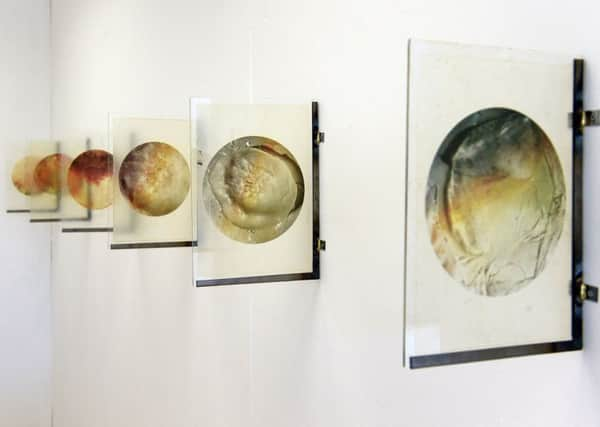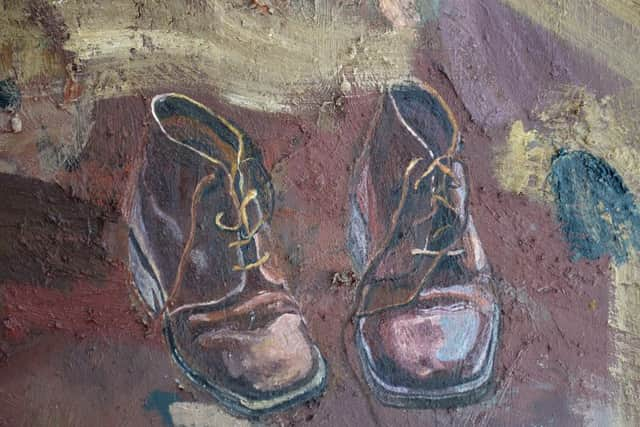Art review: ECA Degree Show 2016


McCallum’s work is part of this year’s Edinburgh College of Art Degree show. Mostly, however, this year the show stays within the College walls, although not all is in its usual accommodation. The painting students are lodged in the modern, former architecture building to the east while their usual magnificent studios are renovated. This gives a different feel to the painting shows. Instead of tall, challenging studios, the students’ work is shown in small, rather intimate spaces in a semi-open plan arrangement.
I don’t know if the ghosts of the architecture students who formerly inhabited these studios have affected them, but there is a distinctly architectural feel to some of the work. Jennifer Gann, for instance, paints in highly formal grids in low key colours, if not simply black and white, to create intriguing pictures that suggest staircases and ordered interior spaces, while ingeniously managing to remain flat. Gavin Wood’s big abstract painting seems more intuitive, but is equally austere in its geometry with an arc of warm grey encroaching on a field of white, punctuated by small rhythmic dots like musical notation.
Advertisement
Hide AdAdvertisement
Hide AdMegan Rae actually uses three dimensional forms apparently abstracted from architectural details, while Freddie Topps makes small, rather beautiful low-key paintings of starkly simple modernist interiors. Grace Woodcock’s work is as formal, but is purely abstract and composed simply of rectangles and grids. Sometimes these overlap to create a composite; sometimes they are semi-transparent to create depth, or they are animated by a sweep of paint that defies the dominant geometry. Flossie McAslan also uses transparency and geometric forms, painting on circles of glass to explore strange, microscopic imagery. Nearby Jessica Fagan’s hanging sheets of painted glass, apparently without subject, are also particularly satisfying. Hannah Ustun’s big paintings seem to echo the formal, high-coloured geometry of Sonia Delaunay and the Orphists, but her smaller works are freer and one or two of them are really radiant.


Not everything is so formal though. Ricard Nauyokas creates rich, crusty textures apparently by some kind of alchemical process of evaporation reminiscent of Glen Onwin’s mysterious chemical landscapes. Thomas Maldonis’s big, roughly painted figures are really wild. A huge black monster eating small blue people is a terrific piece of nightmare imagining. Frances Rokhlin’s small pictures are cooler and more controlled, but have an appealing graphic fluency. This is also true of Ottelien Huckin’s moody figurative work, especially her delicate small drawings. Danny Leyland’s big, bold and forceful paintings are outstanding, however. A memory of Van Gogh’s boots in the foreground of one of them suggests his inspiration, but he also goes beyond. The pigments in his earthy colours seem to have spilled off the canvas to reform themselves as lumpy, earthenware coil pots on the floor in front of them.
Among the work of the painters, there is also one rather fascinating installation. By Mina Heydari-Waite, it is like a shop, except that she has made everything that is displayed, not just pictures, T-shirts and the like, but also vases in glass and ceramic. Tom Johnson is also a painter, but he has made a film. Beautifully constructed, appropriately it pays ingenious homage to Magritte’s surrealist paintings.
As such works demonstrate, the difference between the disciplines is often pretty blurred. Will Cary is a sculptor, however, and has made sculpture his business to the extent that he has dressed in T-shirts the various naked, classical figures from the cast collection that stand around the College corridors. Conversely, undressing seems to be the theme of Troy Holmes’s installation. It is the tacky stage-set for a private strip show with accompanying film of the performer setting it up. Zoe Corbett is also a sculptor. In a series of photographs she seems to get intimate with the sculptural shapes of some massive rocks in a wild landscape, but she has also mimicked them in a large free standing object. Lauren Swanston has been inspired by the illogical world of the Surrealists, perhaps especially Magritte again, to create a whole suite of furniture that behaves in bizarre and unexpected ways. You open a wardrobe door to find a Venetian blind blocking the interior, for instance. Katie Lewin’s installation is a mirrored wall which simply reveals a plaintive inscription in mirror writing, “I see you in my dreams kissing girls who are not me.”
In an artistic statement worthy of the Dadaists, Connie Hurley seems to have assembled all the material to make sculpture, but has left it pretty much at that, unmade. Megan Hampton, on the other hand, has made a series of emphatically sculptural, or perhaps rather architectural objects, massive plaster columns and bases turned on a lathe, but also flexible moulds for ceiling decorations.


Intermedia student Stephanie Wilson has made a wonderful installation of lights and hanging transparent veils of fabric, while in a greenhouse (it is an actual greenhouse attached to the studios) Camilla Lloyd has created an extravaganza of actual and simulated rampant growth overwhelming various art works distributed around it.
It is all very impressive and altogether there are more than 80 graduates across the various disciplines. Perhaps a good many will go on to become artists, but certainly not all. Even if they don’t, however, these graduates together with those from Scotland’s four other art schools will continue to be very valuable products of our higher education. It is in the art schools more than anywhere else in higher education that the cultivation of creative thinking, thinking outside the box, is the goal. We will always need lots of that.